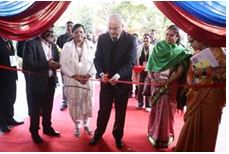



India’s wind energy capacity exceeds 51 GW, ranking fourth globally, but the 140 GW 2030 target faces challenges. Underutilized manufacturing, grid bottlenecks, import dependency, and policy uncertainty hinder progress. Repowering offers potential, but requires clear incentives. Urgent action on infrastructure, localization, and stable policies is crucial for success.

Copyright infringement not intended
Picture Courtesy: DOWNTOEARTH
India's wind power has surpassed 51 GW, but infrastructural and policy challenges pose a threat to renewable energy targets.
As of May 2025, India's installed wind power capacity has crossed the 51 gigawatts (GW), fourth-largest wind energy market in the world.
Gujarat, Tamil Nadu, Karnataka, Rajasthan, and Maharashtra are the leading states in terms of installed capacity. These states benefit from long coastlines and high-speed winds.
India has set a target of achieving 140 GW of wind power capacity by 2030.
Underutilization of Manufacturing Capacity => India has a domestic wind turbine manufacturing capacity of 18 GW annually. However, only 4.15 GW was installed in the 2024-25 period, indicating that less than a quarter of the manufacturing capacity is being used.
Grid Infrastructure Bottlenecks => The transmission infrastructure is not keeping pace with the rate of renewable energy installation.
Import Dependency and Cost Competitiveness => Indian-made wind turbines are estimated to be 30-60% more expensive than their Chinese counterparts. This is largely due to a continued dependence on imported components such as special bearings, gearboxes, and turbine controllers, many of which come from China.
Policy and Regulatory Uncertainty => The shift from a stable feed-in tariff system to a competitive bidding process has introduced volatility and squeezed the profit margins of manufacturers.
Cybersecurity Concerns => The use of imported equipment, especially from countries like China, raises concerns about data security.
Wind Repowering => This involves replacing older, less efficient wind turbines with newer, high-capacity models at existing wind farm sites. This can potentially double or triple the energy output from the same land area without the need for new land acquisition.
Strengthening Grid Infrastructure => The government's plan to expand grid capacity through initiatives like the Green Energy Corridor is a step in the right direction, but implementation needs to be accelerated to match the pace of renewable energy growth.
Financial Incentives => Providing a stable policy environment is required to restore investor confidence. The introduction of a PLI scheme for wind components would provide a boost to domestic manufacturing, to enhance cost competitiveness, and reduce import dependency.
Hybrid Projects => Promoting hybrid projects that combine wind, solar, and battery storage can ensure a more consistent and reliable power supply, addressing the issue of intermittency.
Must Read Articles:
The Wind Energy Potential in India
Source:
|
PRACTICE QUESTION Q. With reference to the concept of 'Repowering' of wind farms, which of the following statements is/are correct? 1. It involves replacing older, smaller turbines with newer, larger, and more efficient ones at the same site. 2. Repowering leads to a decrease in the total number of turbines on the farm but an increase in the total megawatt capacity. 3. This process avoids the need for new site selection and lengthy environmental clearances associated with greenfield projects. Select the correct answer using the code given below: A) 1 only B) 1 and 2 only C) 2 and 3 only D) 1, 2 and 3 Answer: D Explanation: Statement 1 is correct. This is the definition of repowering. Wind farm owners replace first-generation turbines that are less efficient and nearing the end of their life with modern, technologically advanced turbines on the same land. Statement 2 is correct. Modern turbines are much larger and have a significantly higher power rating. For example, ten old 250kW turbines (2.5 MW total) might be replaced by two new 2 MW turbines (4 MW total). The number of turbines decreases, but the overall capacity and energy output of the farm increase substantially. Statement 3 is correct. A major advantage of repowering is that the site is already known to have good wind resources, is connected to the grid, and has existing infrastructure like roads. While some regulatory approvals are needed, the process is generally faster and less complex than starting a new "greenfield" project from scratch. |








© 2025 iasgyan. All right reserved